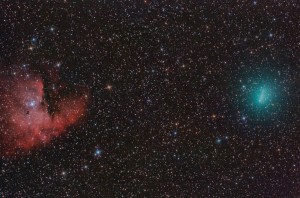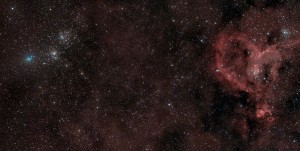最近103p/Hartley猖獗
嗯,猖獗~
2010-10-18,在双子座(Gemini)和巨蟹座(Cancer)之间。
=============================
103P/Hartley的wiki:
http://en.wikipedia.org/wiki/103P/Hartley
————————–
Sky&Telescope的文章,很不错,有图:Comet Hartley 2 At Its Best
http://www.skyandtelescope.com/observing/home/102632669.html
————————–
这里有103P/Hartley的trajactory:
http://www.rasnz.org.nz/Comets/2010Hartley2.htm
————————–
关于103P/Hartley的发现和历史:
http://cometography.com/pcomets/103p.html
=============================
Hartley2将会给我们带来什么?
————————–
NASA的Deep impact计划的后续计划:http://epoxi.umd.edu/1mission/index.shtml
其中第8条便是与Hartley2的接触~
=============================
最后来两张劲爆的图:
http://apod.nasa.gov/apod/ap101007.html
Pacman and Hartley
Credit & Copyright: Jaime Fernández
Explanation: Touring the solar system with a 6 year orbital period, small comet Hartley 2 (103/P Hartley) will make its closest approach to planet Earth on October 20 and its closest approach to the Sun on October 28. It may become a naked-eye comet, just visible in clear, dark skies. Meanwhile the comet has been a tempting telescopic target, seen here with an alluring green coma as it shares the frame with emission nebula NGC 281 and stars of the constellation Cassiopeia on October 2. The nebula’s gaping profile defined by dust clouds against the red glow suggests its more playful moniker, the Pacman Nebula. An apparent short bright streak shows the comet’s motion against the background stars during the hour of accumulated exposure time. Over the next few days Comet Hartley 2’s motion will also carry it across a field of view featuring the famous double star cluster in Perseus. On November 4 a spacecraft from planet Earth will actually fly within about 700 kilometers of the comet’s nucleus. Now dubbed EPOXI, that spacecraft was formerly known as Deep Impact.
http://apod.nasa.gov/apod/ap101014.html
Clusters, Hartley, and the Heart
Credit & Copyright: Rogelio Bernal Andreo
Explanation: An alluring Comet Hartley 2 cruised through planet Earth’s night sky on October 8, passing within about a Full Moon’s width of the famous double star cluster in Perseus. The much anticipated celestial photo-op was recorded here in a 3 frame mosaic with greenish comet and the clusters h and Chi Persei placed at the left. The well-chosen, wide field of view spans about 7 degrees. It extends across the constellation boundary into Cassiopeia, all the way to the Heart Nebula (IC 1805) at the far right. To capture the cosmic moment, a relatively short 5 minute exposure was used to freeze the moving comet in place, but a longer exposure with a narrow-band filter was included in the central and right hand frames. The narrow-band exposure brings out the fainter reddish glow of the nebula’s atomic hydrogen gas, in contrast to the cometary coma’s kryptonite green. In the past few days, comet watchers have reported that Hartley 2 has become just visible to the unaided eye for experienced observers from dark, clear sites. On October 20, the comet will make its closest approach to Earth, passing within about 17 million kilometers. On November 4, a NASA spacecraft will fly by the comet’s small nucleus estimated to be only 1.5 kilometers in diameter.



忘了到你这儿来了。更新了很多嘛!导航网比原来漂亮多了,而且看起来很正规。
再提一点,那几个字最好做成当鼠标指向时,有明亮变化。
我打算把导航页去掉了~
等我把所有的东西都移到WordPress中来,那个导航页就没有用了。很多时候导航页其实是在浪费访问者的时间。
噢,有理。